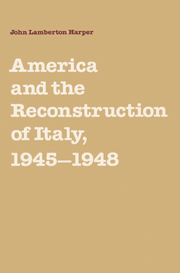Book contents
- Frontmatter
- Contents
- Preface
- Frequently used abbreviations
- 1 Introduction and overview
- 2 Wartime diplomacy
- 3 Liberation and transition
- 4 The advent of De Gasperi
- 5 Clayton at bay
- 6 Corbino, UNRRA, and the crisis of the liberal line
- 7 The emergency response
- 8 The “whirlwind of disintegration”
- 9 The dilemmas of deflation
- 10 Conclusion: the Marshall Plan and after
- Notes
- Bibliography
- Index
7 - The emergency response
Published online by Cambridge University Press: 11 September 2009
- Frontmatter
- Contents
- Preface
- Frequently used abbreviations
- 1 Introduction and overview
- 2 Wartime diplomacy
- 3 Liberation and transition
- 4 The advent of De Gasperi
- 5 Clayton at bay
- 6 Corbino, UNRRA, and the crisis of the liberal line
- 7 The emergency response
- 8 The “whirlwind of disintegration”
- 9 The dilemmas of deflation
- 10 Conclusion: the Marshall Plan and after
- Notes
- Bibliography
- Index
Summary
INTRODUCTION
The elections of November 1946 in both Italy and the United States marked the convergence of trends that had threatened to undermine the foundations of American foreign economic policy throughout the early postwar period. The clouds of domestic discontent burst forth on November 5, producing a landslide victory for the Republican Party. On November 10, economic distress and political paralysis in Italy produced an equally dramatic defeat for the Christian Democratic Party at the hands of right- and left-wing forces. The elections left De Gasperi more vulnerable than ever, but the simultaneous political shift in the United States raised doubts about post-UNRRA aid to Italy and other foreign nations. Indeed, the arrival of a Republican Congress in Washington posed a serious challenge to the Hullian initiatives pursued by Democratic administrations since the days of the Atlantic Charter.
The period between the November elections and the convening of the Eightieth Congress in January 1947 was thus one of deep uncertainty. Pressure from all sides threatened to topple De Gasperi and bring general political chaos. Even though the State Department was in no position to respond to De Gasperi's urgent calls for aid, his predicament helped to reinforce a growing consensus within the department based on the longstanding view of EUR and Henry Tasca that communist subversion was the primary threat to economic recovery. For the first time, EUR professionals and Hullian economists joined in a common response to the Italian crisis.
- Type
- Chapter
- Information
- America and the Reconstruction of Italy, 1945–1948 , pp. 105 - 117Publisher: Cambridge University PressPrint publication year: 1986



